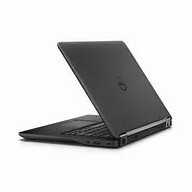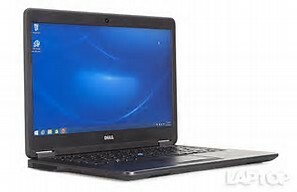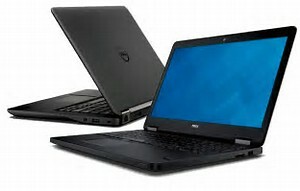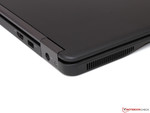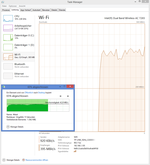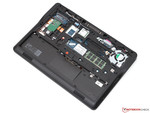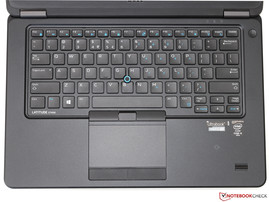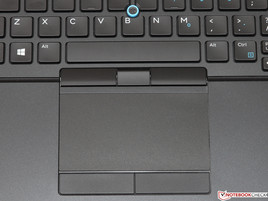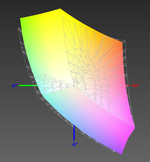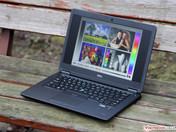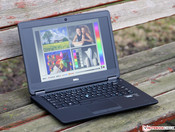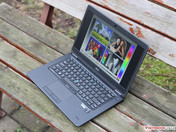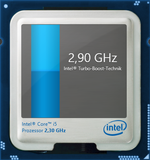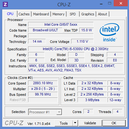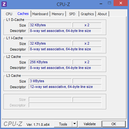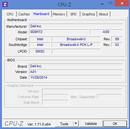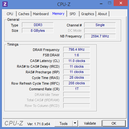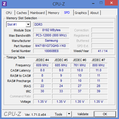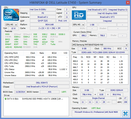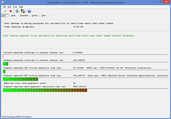Used Dell latitude Laptop E7450 core i7 5th Gen /16GB Ram/ 1TB Hdd win10
Description
Item specifics
| Condition: |
New: A brand-new, unused and undamaged item.
|
Brand: | Dell |
| SSD Capacity: | 256gb or 1tb hdd any one | MPN: | DELL74506839 |
| Family Line: | N/A | Operating System: | N/A |
| Type: | N/A | Processor: | Intel Core i7 (5th Generation) |
| Usage Type: | Business | Memory: | 16 GB |
| Product SKU: | IB-EBY261818661640 | Hard Drive Capacity: | 1000gb |
| Warranty: | Seller Warranty | Colour: | N/A |
| UPC: | 8 |
Dell Latitude 14 E7450 Ultrabook Review
Evolution instead of revolution. The Dell Latitude is equipped with Intel's latest CPU generation Broadwell and wants to get the top spot in the business segment, currently occupied by the Lenovo ThinkPad T440s. What are the advantages of the modern 14-nm technology for the user and does the 14-inch notebook have any other highlights – we tested it.

For the original German review, see here.
The launch of a new CPU generation is a good chance for many notebook manufacturers to rework their own product portfolio. Therefore, it is not really surprising that there is currently lots of news about new devices that are focused on Intel's latest Broadwell chips with 14-nm architecture.
Dell also uses this opportunity, and reworks some of its most popular products, including the Latitude-series that are designed for business users. This review is focused on the 14-inch model Latitude 14 E7450.
Depending on the configuration, prices range between 1069 and 1429 Euros in Germany (~$1225 and ~$1637) – but VAT, shipping (currently free) and additional extras from the online seller are not included yet. Our review unit, with a Core i5-5300U processor, 8 GB of RAM, 128 GB SSD and a Full HD display is available for a considerable net price of 1600 Euros (~$1833). The E7450 is certainly no bargain, but the pricing is also similar to the Lenovo ThinkPad T440s or the HP EliteBook 840 G1. These devices have not had the Broadwell refresh yet, so we have to compare the Latitude with the current Haswell rivals at this point.
Overview Latitude 14 E7450 configurations (excerpt):
It is a matter of taste whether you think the matte black chassis is dull and boring or simple and elegant, but one thing is certain: Far more important than the design, are the qualities of a professional notebook. Dell has done quite a good job in this regard and designed a chassis made of magnesium and other metals. The device was even tested according to military standards (MIL-STD-810G), but the E7450 is still quite light at 1.64 kilograms (~3.6 lb) and even beats the rivals from Lenovo (1.7 kg; ~3.7 lb) and HP (1.78 kg; ~3.9 lb). Combined with compact dimensions, the device is certainly a good mobile companion for your next business trip.
However, the rather slim construction does not only have advantages: Critical users might not be happy with the slight flexibility of the base unit, but we do not want to overstate this. There are no creaking or clattering sounds even under a lot of pressure, this is not a matter of course even in this price range. We also want to praise the above-average stability of the display, including the precise hinges that had already left a great impression in the review of its similarly constructed predecessor model.
Unlike the so-called unibody cases, the chassis of the Latitude consists of multiple individual parts. The manufacturer has assembled them very well, and we can hardly find any uneven gaps, which is an example of the high build quality of the device in all areas. We also like the haptics of the Ultrabook with its soft-touch surfaces, even though they collect dirt quite quickly.
Connectivity
Except for a single USB 3.0 port and the headset jack, there are no ports on the sides of the E7450 – the manufacturer has located them at the rear to improve the handling. Cables and bulky devices do not really affect the operation at this position, but it can be more complicated to attach everything.
The port variety does not really leave anything to be desired: As well as two additional USB 3.0 ports, there are two digital video ports (HDMI and Mini-DisplayPort) and the Gigabit LAN. You might overlook the SD card reader at first glance since its location low down on the left side of the case is not really perfect.
Dell also offers several optional accessories; starting with a simple VGA adaptor all the way up to real docking stations. The corresponding port at the bottom of the device has not changed, so you can still use old docking solutions like the Dell E/Port Replicator II.
Communication
In parallel with the introduction of the first Broadwell models, Intel has also launched a new WLAN module, Dual Band Wireless-AC 7265. Like the predecessor, Wireless-AC 7260, it supports the WLAN standards 802.11a/b/g/n/ac in 2.4 and 5 GHz networks as well as Bluetooth 4.0. Even though the nominal performance specifications have not changed (2x2 dual-stream, up to 876 Mbps), Intel still promises improved transfer rates combined with reduced power consumption – we obviously verified this immediately.
The results are actually quite good: We managed to transfer files with an impressive transfer rate of 43 MB/s in combination with a TP-Link Archer C7 router. This is a small increase compared to earlier reviews with the Wireless-AC 7260. These speeds are obviously only possible in good conditions (802.11ac dual-stream, short distance, no walls), but the performance of the wireless module was also impressive at a longer distance, and we always had a stable and fast connection. You can use the optional WWAN module (Qualcomm Gobi 4G/LTE, extra 69 Euros, ~$79) if there is no wireless network nearby.
Unfortunately, the picture quality of the webcam, which still has a maximum resolution of 0.9 Megapixels, is not a revelation: Washed-out colors, lack of details and visible picture noise make it only usable for chat applications like Skype at most. We liked the great array microphones with the excellent voice quality much better.
Security
Business customers that want certain security features should pay close attention when they select the model. Many features like a fingerprint reader, SmartCard reader, NFC or Computrace support are not standard for all configurations – only a Trusted Platform Module (TPM) is always included. Detailed explanations about the individual functions are available in our FAQ.
Accessories
In addition to the power adaptor and some brochures, the Latitude comes with an 8 GB USB stick that can be used as a recovery drive for the preloaded Windows 8.1 Pro. Other manufacturers usually only include a DVD that requires an additional external optical drive – it is nice that Dell thought about this.
The software installations on the system are clean, and there are no annoying trial versions. There are some preloaded tools from the manufacturer, but they are primarily designed to maintain the device, for example, to create a recovery or manage wireless networks. Dell trusts Microsoft's Windows Defender for protection against viruses and other malware. This application – unlike many third party apps – uses pleasantly few resources and is not obtrusive.
Maintenance
After the removal of the battery, you just have to loosen two screws before you can remove the large bottom cover of the notebook. After that you have access to the two DDR3 memory slots (one occupied), a 2.5-inch tray for storage drives (occupied), the WLAN module as well as a free spot for a WWAN card (M.2). Exemplary: Dell has already integrated the necessary antenna cables. It is just as easy to clean the fan.
Warranty
Like Lenovo or HP, Dell also offers a three-year warranty for its expensive business models, so the high retail price is at least somewhat compensated. As usual, you can extend the service pack at a price – even a 24/7 phone support for up to 5 years is possible if you can afford it (around 280 Euros; ~$321).
Input Devices
Keyboard
So far, Dell has been using conventional keyboards to equip its Latitude-series, but now they have changed to the popular chiclet design. The 14 x 14 mm (~0.55 x 0.55 in) large keys are slightly concave, that ensure high accuracy and you also get a two-stage LED backlight. Our German readers might be rather surprised when they see the unusual layout since our review unit uses the US layout, but you can obviously order other versions (German, French).
But enough of the design features – what about the subjective typing experience? We definitely want to praise the firm and precise pressure point, which does not suffer from bouncing, even in the center of the keyboard. In addition, there is a generous travel span, which is just slightly shorter than the current ThinkPads – basically it is a matter of taste which one you prefer. Another positive aspect is the very restrained noise development; the keyboard is very quiet even during fast typing.
Touchpad & TrackPoint
Below the keyboard is the touchpad with increased dimensions of 10.0 x 5.4 centimeters (~4 x 2.1 in) that supports gestures with two, three or four fingers. Fingers have no problem to glide above the smooth surface, which can be automatically deactivated when you use the keyboard to avoid accidental inputs. The ergonomics benefit from Dell's decision to equip the E7450 with dedicated mouse buttons and a firm stroke - you know what we mean if you have ever used drag and drop commands on a modern ClickPad.
You can also use an additional TrackPoint if you have decided to equip the notebook with the backlit keyboard at an additional cost of 20 Euros (~$23). We do not want to talk about the pros and cons compared to a touchpad, but the small joystick does a great job as an optional mouse replacement. Precision and response are just as flawless as the three smooth buttons; the middle one can be used for scrolling.
Display
Even though it is the year 2015, the standard display for the Latitude 14 is still an antiquated WXGA panel with a meager resolution of 1366x768 pixels. We definitely think you would save money on the wrong end with this panel. The optional Full HD panel is much more interesting: You can almost see twice the amount of information with 1920x1080 pixels and the pixel density has increased from a low value of 112 ppi to a much more comfortable 157 ppi. This is not only a visual improvement, but the productivity also benefits from the additional screen.
The optional and more expensive premium displays usually also have a better picture quality, more powerful background illuminations and higher resolutions. We have not tested the WXGA model so far, but at least the renewed Full HD version once again manages quite a good result with 257 cd/m². Both the EliteBook 840 G1 (280 cd/m²) as well as the ThinkPad T440s (282 cd/m²) are slightly brighter than the E7450, while the AsusPro BU401LA (209 cd/m²) falls noticeably behind. The somewhat uneven brightness distribution of our review sample is subjectively not an issue and we could not see any annoying screen bleeding.
|
|||||||||||||||||||||||||
Brightness Distribution: 75 %
Center on Battery: 280 cd/m²
Contrast: 933:1 (Black: 0.3 cd/m²)
ΔE Color 3.45 | - Ø
ΔE Greyscale 3.35 | - Ø
92% sRGB (Argyll) 60% AdobeRGB 1998 (Argyll)
Gamma: 2.37
| Dell Latitude E7450 | Lenovo ThinkPad T440s 20AQ006BGE | HP EliteBook 840 G1 | |
|---|---|---|---|
| Screen |
4%
|
-82%
|
|
| Brightness |
257
|
293
14%
|
280
9%
|
| Brightness Distribution |
75
|
86
15%
|
87
16%
|
| Black Level * |
0.3
|
0.36
-20%
|
0.69
-130%
|
| Contrast |
933
|
844
-10%
|
406
-56%
|
| Colorchecker DeltaE2000 * |
3.45
|
3.45
-0%
|
9.41
-173%
|
| Greyscale DeltaE2000 * |
3.35
|
1.94
42%
|
10.19
-204%
|
| Gamma |
2.37 101%
|
2.58 93%
|
2.49 96%
|
| CCT |
6940 94%
|
6399 102%
|
12671 51%
|
| Color Space (Percent of AdobeRGB 1998) |
60
|
51
-15%
|
40
-33%
|
| Color Space (Percent of sRGB) |
92
|
* ... smaller is better
The technical specifications of the display are similar to the IPS panel of the Lenovo T440s (AUO B140HAN). The rich black value (0.3 cd/m²) results in an excellent contrast ratio of 933:1 – TN panels usually only manage values between 200 and 500:1. This means the user gets a very rich and vivid picture, so the Latitude can also be used for multimedia purposes.
You get quite an accurate display ex-works. Colors and grayscale are close to their ideal values with DeltaE deviations of around 3.5, and our additional calibration can lower the results by another 1.5 points (DeltaE colors: 2.1; grayscale: 1.8). At the same time it adjusts the color temperature, which is a little too cool in the factory settings. Only professional graphics artists or photographers will criticize the limited color space, even though 92% sRGB (Correction 20.5.2015 due to a wrong sRGB-reference-profile) and 60% AdobeRGB are more than acceptable for this type of notebook.
Thanks to the anti-reflective coating, reflections are not really a problem for the bright display, so you can easily see the picture contents outdoors. However, you would like to have an even brighter panel under direct sunlight – but you would need more than 300 cd/m² for a visible difference, and hardly any rival can manage such a luminance either.
One reason for the popularity of IPS displays is the high picture quality when you look at the display from the side. The AUO panel of our review unit manages to display a picture almost without distortions even with angles of around 45 degrees. A lower contrast and color accuracy are only an issue when you exceed this value, from an angle above in particular. Compared to cheap TN panels, you do not have to adjust the opening angle of the display with each head movement.
Performance
We managed to get an impression of Intel's new 14-nm architecture "Broadwell Core-M platform, after it was launched last autumn. It is now also available in several LV (low voltage) and ULV (ultra low voltage) models for more powerful Ultrabooks. Dell has equipped the Latitude E7450 with the Core i5-5300U from the comprehensive list of available models. It is a fast upper-mainstream dual-core processor with a TDP of 15 Watts. One noticeable difference compared to the predecessor is the much higher nominal clock of 2.3 GHz, whereas the individual Turbo limits – 2.7 GHz for two cores, 2.9 GHz for one core – were barely raised.
The integrated graphics unit is new as well, in the case of the Core i5-5300U, the HD Graphics 5500. This medium version is referred to as "GT2" configuration and has 24 Execution Units that are clocked with 300 - 900 MHz. Compared to the previous HD Graphics 4400 (20 EUs), the HD 5500 is not only supposed to be significantly faster, but it also comes with new features such as full support for DirectX 11.2.
The memory module of our review unit is quite generous with 8 GB DDR3L-1600 of RAM, but the manufacturer has integrated only one module. As a result, the memory controller only works in the slower single-channel mode, which can affect the 3D performance significantly. But it also makes it easier to upgrade the memory since there is a second empty slot. We think the 128 GB SSD is rather small, but there are other configurations with larger drives (currently up to 256 GB) to choose from.
Processor
We have already mentioned that Broadwell does not have much higher clocks than comparable Haswell models, at least when we look at the Turbo Boost. But the new generation does have two big advantages: First, thanks to the 14-nm manufacturing process, the power consumption has been reduced, so the TDP does not limit the clock so often. Intel has also been able to increase the per-MHz performance by another 5% – not a huge improvement, but still respectable when you consider the high level of the predecessor.
As expected, the Core i5-5300U can maintain the full 2.7 GHz even under continuous load for both cores, and it can even exceed a Core i7-4600U or i7-4650U in longer benchmarks. The advantage over the Core i5-4300U is between 5 to 10%, depending on the scenario and test device. The Broadwell chip runs with 2.9 GHz in single-thread benchmarks and is roughly between the Core i5 and Core i7 chips from the Haswell generation.
Dell does not restrict the clocks artificially on battery power, so you can use the full performance of the processor on the road.
| Cinebench R11.5 | |
| CPU Single 64Bit (sort by value) | |
| Intel Core i5-5300U |
|
| Intel Core i7-4600U |
|
| Intel Core i7-4650U |
|
| Intel Core i5-4300U |
|
| Intel Core i5-4200U |
|
| CPU Multi 64Bit (sort by value) | |
| Intel Core i5-5300U |
|
| Intel Core i7-4600U |
|
| Intel Core i7-4650U |
|
| Intel Core i5-4300U |
|
Opps
Sorry, it looks like some products are not available in selected quantity.
.png)



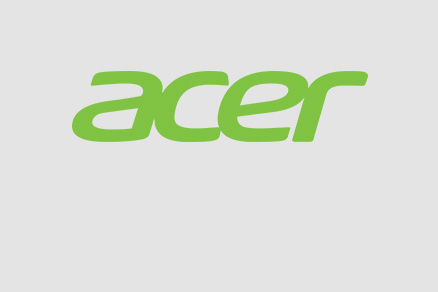

.png)



